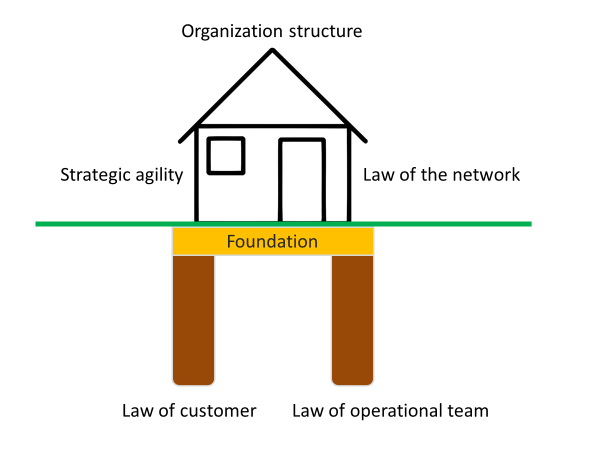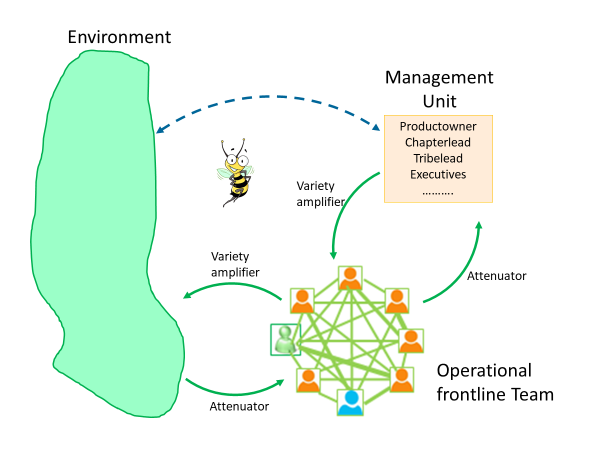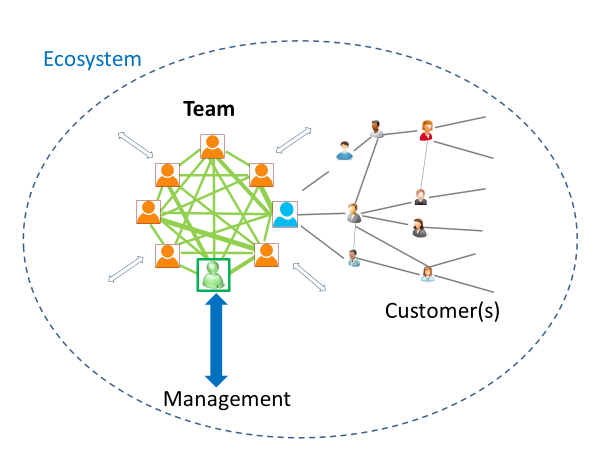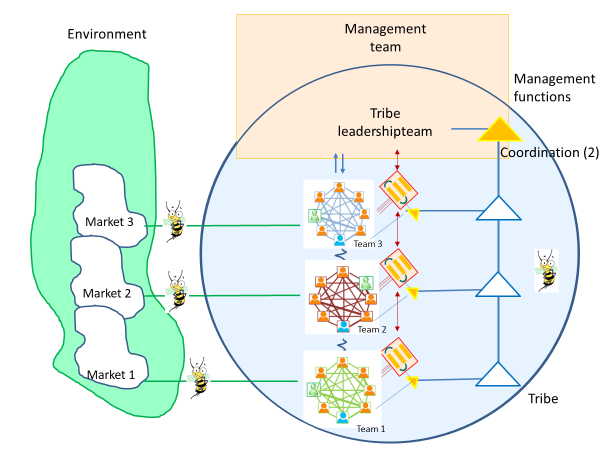Systems Thinking31
Build a network of viable teams for business agility
Kas Burger
March 3, 2019
Kas Burger
March 3, 2019
Only variety of frontline teams can absorb variety from business environment: law of requisite variety is the decisive argument to position and value frontline teams interacting with their customers in business agility.
- by Kas Burger
The network of teams is promoted in many places. Steve Denning presents in his new book: The age of agile, for example the 'law of the network' as one of the three pillars for a work environment with an agile mindset or for business agility. Recently, the Scrum Alliance also added its contribution with scrum@scale. Another movement focuses on teams with a lot of self-management that characterizes the self-organization. It is not that difficult to visualize a network of teams, but then you do not solve the question of how well a network of teams could turn out. I ask myself how a network could be dynamic with autonomous frontline teams and still be vertically aligned with strategy. In agile we say goodbye to pyramid bureaucratic organization structures and inspired by Intel and Google introduce OKR performance systems and not surprisingly a new pyramid structure is created. Strategy alignment often overwhelms values like empowerment, autonomy and trust.
All well and good, but teams or their team leader should also be 'accountable' to ... management? And in order to obtain extra resources (talent, time or money) to better serve the customer, the frontline team is asked to write a well-founded business case and then, due to the slow procedures, they would have to wait months for an answer. In this way agility vanishes like smoke in the wind. Hamel fulminates against bureaucracies and proposes to move from a hierarchy of authority to a hierarchy of competencies. And how does accountability fit into Hamel’s view? How to organize the information flow and which consultation or meeting structures are relevant for business agility? The perspectives of organizational and learning psychologists offer too little perspective, even though learning has been promoted to strategy (in the platform economy). I think we need a guidance or something to fall back on, that makes it easier to structure business agility. It is time to consult the experts of organization, like Mintzberg or the system builders of Management Cybernetics like Stafford Beer. In this post I will elaborate further on the interaction between operational teams and customers. In my second post I will elaborate on the management functions.
We live in the era of artificial intelligence and agile. Steve Denning describes in his recent book that business agility has three pillars:
The 'law of the customer' is not by coincidence number one. Denning refers to Peter Drucker, who argues that the only reason for the existence of the company is the customer. The customer should be leading in everything companies do and how the organization is structured. In his new book, Denning makes it clear that many companies say they are customer-oriented, but that they do not coordinate their processes and the organization of the company accordingly.
In the agile manifesto the highest priority is to satisfy the customer. In the agile methodology or agile framework, the product owner is responsible for the customer stories (user stories) and in the review meeting the team justifies its minimum viable products to the customer. Sounds good, but in how many companies is the customer actually participating in the review meeting? How often do you not see that customer service represents the voice of the customer? Are teams afraid to present an unfinished, a minimum viable, product to customers and end-users? Is the reputation of the business at stake? Barclays gives a good example with agile teams on the stock market floor and in municipalities the purpose teams would organize review sessions in the municipality. Organize the review sessions at customers’ place with the post-it wall at the customers’ place and not at the companies’ office. Be transparent starting with customers, that is the basic idea behind the agile manifesto.
In the business agility conference 2018, James Allen of Bain & Company presented an impactful approach. Bain & Company aptly describes that growing companies often fail to keep the pioneers (founder's) and entrepreneurial mindset, while they need that 'insurgency' in a rapidly changing environment. Companies with a pioneers or 'founders' mentality have three overarching elements:
What appeals to me is that Bain & Company focuses on the interaction between the frontline team with customers and that the rest of the organization is in fact at the service of this interaction. These are also the first two pillars of Denning and they become extra powerful when they are connected to each other. The pillars and the connection between frontline teams and customers form the foundation for building a viable, agile business.

Time to switch to the Viable systems model (VSM) of Stafford Beer. The model offers a solid framework that provides guidance for smartly organizing and strengthening the network. The VSM is about the capabilities of a system, read the team, an organism, a department, an organization, to be viable. Beer defines viable as the ability of a system to continue to exist independently, balanced with its environment. Beer uses nature and cybernetics as a source of inspiration; where each organism must be able to deal with the complexity of its environment. The model is based on maximum autonomy of each (sub)system and that fits into agility.
The Beer system approach provides insight into the dynamics between teams. He emphasizes that organizations facing disruptions must intervene on the interaction between teams (systems), at all levels of the organization. According to Beer, the clue is who interacts with whom (which (sub)system with which other (sub)system) and how all parts of an organization in a flat and self-organizing structure would work together in order to achieve resilience, flexibility and excellence. Beer offers a guidance to facilitate flourishing interactions. The USA army in Iraq became painfully aware that the interaction between teams is the key factor for successful operations:
General McChrystal experienced the enormous disadvantages of a bureaucratic army. The superior American army suffered enormous losses against a very flexible and poorly armed enemy. The US Army was far too slow. He saw that the problem was not in the cooperation within teams, but rather in the cooperation between teams. The cooperation with partner organizations was much worse. The solution was a network of teams with a team-of-teams.
Variety as indicator for complexity plays an important role in the viable system model of Beer. A system is viable as long as it is able to absorb the external variety. Teams are viable systems and as such autonomous and they independently process the information from the environment. Finally, they have the context specific knowledge about the environment. The starting point of Beer is that the capacity to absorb is the greatest where the variety comes in. Here the law of the so-called 'requisite variety' applies:
Only variety can absorb variety
The (frontline) team absorbs as much as possible all the variety that its rich environment has to offer. Diversity in operational teams would be helpful to be able to absorb the variety

The frontline team then filters its information for the management. This means that the management can only partly understand the reality of the environment in which the team is operating. Also, the management can in turn add extra variety to the team; for example, with information from other departments or tribes or from the strategy drawn up by management. The team can in turn add new information to its environment. And of course, the subject matter specialists work in the frontline teams; for example, in banks the mortgage specialist works in frontline teams, it is in the business interest that these specialists interact with the variety of the environment.
Beer argues that the team absorbs the variety from its environment and ‘higher’ levels in the organization should not interfere. If they interfere, it will affect the viability of the team. You can ask yourself whether it is legitimate to intervene in a viable system. The operational team is therefore responsible for the relationships and coordination with their customers in their market segment.This applies also for municipalities:
In the complex environment of the municipality with a purpose-oriented approach, the youth purpose team for example has the knowledge, expertise and information about youth in the municipality. This team is also very aware about what is happening in the municipality regarding the youth issues. In line with the Beer approach, the purpose team absorbs the external variety. The hierarchy, read managers, the alderman or the city council support the purpose team and provide information, so that the purpose team can absorb the variety from the environment even better. The hierarchy should not want to interfere with the interactions between the youth team and inhabitants. Unfortunately, this often happens and it is not surprising that the ability of teams to properly absorb all external events is restricted or limited. In the terminology of Beer, you ask for difficulties.
The Chinese company Haier is also a striking example.
Haier uses the platform concept and defines a network organization as an ecosystem without borders with a management without managers. They created self-organized units (micro-enterprises). Haier does no longer try to delegate to, or ‘empower’ employees; every employee is his or her own boss. Ownership is so obvious and it avoids all those complicating accountability discussions. There are no hierarchies and managers: the platform owner, and that is often the CEO, is for example a servant responsible for feeding (watering) the ecosystem (see also McCrystal). What makes Haier outstanding is that an autonomous team, a cell, can recruit and dismiss people themselves and that the income of team members depends on the sales by the team. The team manages its own scarce resources and fits seamlessly within the Beer approach.

In Bain & Company's Founder’s mentality approach, everything is focused towards ensuring that the teams with their 'franchise player' can optimally handle the variety from the environment in their micro-battles and can immediately anticipate on new information. The management lead is supporting, listening and learning from the frontline team. This attitude from the management lead is a logical choice when the organization wants to understand the variety in the environment and is willing to act upon. In business agility vertical alignment and business strategy will be positioned differently; the business strategy will result from patterns distracted from the frontline teams and for example a cascading of OKR’s from the top does not fit into this.
You could also consider a network of teams as a system, where the operational frontline teams are connected to their customers.

The 3 teams in the tribe, visualized above, absorb and handle the variety from the environment. The cooperation between the teams is organized in such a way that all changes in the outside world are optimally anticipated. The management unit of a tribe consists of the tribe leadership team organizing periodically team-of-teams meetings. They create conditions that teams are able to absorb the variety from the environment.
Teams in a network of teams (tribe) are dependent on each other and this requires coordination (2). Rules are required to deal with disruptions from one subsystem (team) that affect other subsystems; or in terms of Beer the oscillations of a team that affects other teams must be damped. This coordination takes place between teams and also takes place at a so-called higher recursion level: in team-of-teams consultations and with the tribe (department) leadership team. The tribe leadership team has the function to monitor the cooperation between teams; to check whether the horizontal alignment is well organized by the teams and facilitate optimal cooperation. They create conditions that teams have the ability to arrange alignment as much as possible themselves (Kniberg, 2015). The added value of this higher recursion level is that this function has a broader overview; since there are people who have information about what is happening in other teams and in the organization. Beer's starting point is that managing dependencies between teams requires no insight into what happens in the teams themselves (Beer, 1979).
Teams (operational units) work together to achieve desired results and they make the mutual dependencies manageable. Therefore, they make meaningful and effective mutual agreements and they set up the processes that are serving and not leading and are immediately adapted if the circumstances require it. The Coordination (2) function organizes the information flow to signal when rules and agreements between teams are violated. In addition, it is crucial that all parts communicate with each other and share all relevant information with each other and agree when consultation is necessary. The better this goes, the less the management function has to interfere and the greater the stability in the organization. In case of friction or conflicts between teams, people who mainly operate in management functions, the higher recursion level, will have to resist the temptation to seize the hierarchy. They have a supporting role so that both teams can reach an agreement. To this end, they will check, among other things, whether all arguments are on the table and whether the balance between these arguments is correct. It is the task of an A&L-advisor at the tribe level to support and facilitate the interactions between the teams and strengthen horizontal alignment; you could call it a senior Agile &Learning advisor (agile coach).
In business agility a frontline obsession is vital. The law of 'requisite variety' provides an additional argument that operational teams are the actor to absorb variety from the rich environment allowing to respond to the complex business environment for customer delight. The management then has the task of nurturing these teams and the team-of-teams, providing resources with decisiveness; to ensure that these teams do not dry out but can actually flourish. The viable system model from Beer provides a guidance to position the operational team well. Beer defines viable as the ability of a system to continue to exist independently, balanced with its environment. The meaning of viability refers to autonomy and self-management. I come to the insight that the organization and meeting structure with a sharp view on roles of people resulting from the agile core values, plays a major role allowing teams and team-of-teams to be highly successful.
Please subscribe and become a member to access the entire Business Agility Library without restriction.